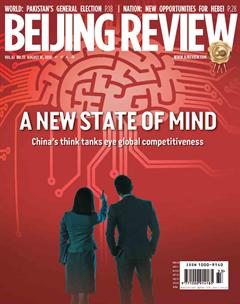A THINK TANK GROWS IN CHINA
By Chi Fulin
In recent years, Chinas think tanks have entered a rapid development era. In some fi elds and areas, there is a growing think tank mania, which is a relatively new phenomenon in the country, reflecting the urgent need for think tanks in society.
This year marks the 40th anniversary of Chinas reform and opening up, which is at a new historical juncture. The economy and society are undergoing transformation, which demands arduous efforts in further reform and opening up. We are facing a series of major issues that require think tanks to research with initiative and bring out valuable suggestions for decision making.
The China Institute for Reform and Development (CIRD) is based in south Chinas Hainan Province and has long been dedicated to studying and researching major strategic issues in Hainan. We have compiled many important reports and policy proposals for the Hainan Provincial Government.
On November 1, 1991, the CIRD was established and held a seminar on the opening-up strategy of Hainan, focusing on establishing special duty-free zones on the island. In 2001, when China was poised to join the World Trade Organization, the CIRD took the lead in initiating the idea of building Hainan into an international tourism island and submitted a study report regarding the feasibility of the proposal. From 2007 to 2009, it prepared an annual report on this project.
In recent years, the CIRD has submitted almost 100 reports to the Hainan Provincial Government on issues such as building special environmental protection zones, establishing an international tourism island and constructing a free trade port.
There are two important points in the construction of a new type of think tanks with Chinese characteristics. One is that we must adhere to the problem-oriented strategy and try to play a role in the policy-making processes of the Communist Party of China(CPC) and the Chinese Government.
For example, in the mid-1990s, there was a heated debate on the term of the rural land contract. The CIRD, after extensive research and investigation, submitted to the Central Government the proposal of“granting farmers long-term and guaranteed land use rights,” which was eventually adopted at the Third Plenary Session of the 15th CPC Central Committee.
After the SARS crisis in 2003, the CIRD put forward a package of policy proposals including transforming from a government preoccupied with economic construction to a public service government and promoting the equalization of basic public services.
In 2017, the CIRD compiled a proposal with 30 suggestions on further reform policies for 2017 to 2020, providing an important reference for the government.
The other point in constructing a new type of think tanks is innovation, especially institutional innovation. This should be stressed more in think tank construction to maintain objective independence, strengthen professionalism and shape rational and responsible new think tanks.
In China, think tanks are still a new thing. They are different from regular academic groups, which focus mainly on academic research. Think tanks provide advisory services for decision making based on academic research. They are also different from the media. They shoulder an important responsibility in reaching social consensus through their own research.
To strengthen the construction of new-type think tanks with Chinese characteristics, we should focus on their functions for public service as non-profit organizations. We should also create a sound institutional and social environment for their development.

